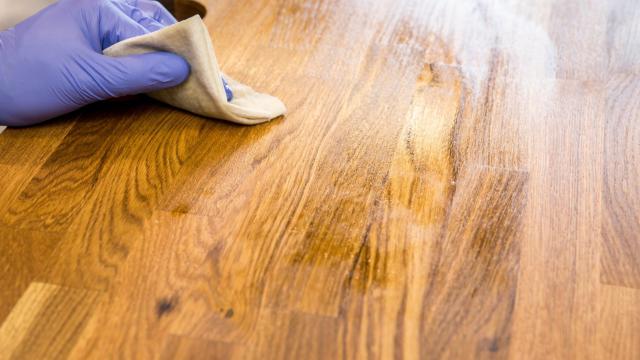Butcher block countertops are convenient and attractive, but if they’re not maintained well, they can crack or even develop mould. You can avoid these issues and keep your kitchen surface functioning and looking like new with a only a little bit of effort.
Gather your materials
For this project, you’ll need cleaning supplies; 100 and 150 grit sandpaper; food grade mineral oil; clean, lint-free rags; and a five-in-one scraper (or dough scraper). Make sure to wear gloves as well. If there are any small cracks in your countertop, you will also need some canning wax or food-safe wood glue.
Clean and prep your surface
First, wipe away any dirt or residue with a damp rag. (Some people like to use vinegar to clean wooden surfaces as it helps to disinfect and won’t damage the grain.) Then, use a dough scraper or a five-in-one to lift off any stubborn bits.
To remove wine stains, you can use a three-per cent hydrogen peroxide solution and a cotton swab. Dab the peroxide on the stain, let sit and remove by blotting with a dry rag or paper towel. Use this method sparingly, as hydrogen peroxide can lighten unstained parts of your wood.
You can also use bleach to remove mildew stains. (This is where the gloves come in.) Dissolve one teaspoon of powdered bleach or sodium percarbonate in one cup of hot water and apply to the counter with a stiff bristled brush. Let sit 10 minutes; at this point you should notice the wood beginning to lighten. Repeat with a fresh batch of bleach until the stain is gone.
Sand and smooth your countertops
Sand out nicks and burn marks with your 100 grit sandpaper. Once these are smooth, you can move on to sanding the whole surface — first with 100 grit paper, then with 150 grit. If you have a palm sander, this step will definitely go faster, but a sanding block and some patience will also do the trick. Make sure to vacuum or wipe away any residual sawdust so that your counters will be smooth and sleek once finished.
Repair small cracks
To fill small cracks in your countertop, I recommend one of two methods: Fill the crack with food-safe wood glue, wipe away the excess glue, and sand once dry; or heat some canning wax in a saucepan and pour it into the crack. Wait until the wax is partway solid, but not hard, and scrape away the excess with a five-in-one.
Apply your finish
Once your counters are scrubbed up and smooth, it’s time to apply your finish. This step will protect your counters from too absorbing too much moisture, and will also condition the wood so it doesn’t dry out.
Rub your mineral oil (or a butcher block conditioner) into your countertop with a lint-free cloth and then let stand for 20 minutes. Buff the surface with a cloth. Repeat this process whenever you notice that your butcher block is looking dry. (A little TLC goes a long way.)

Leave a Reply
You must be logged in to post a comment.